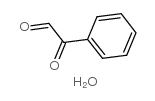Inhibition of the mitochondrial permeability transition by aldehydes.
William A Irwin, Lawrence D Gaspers, John A Thomas
Index: Biochem. Biophys. Res. Commun. 291(2) , 215-9, (2002)
Full Text: HTML
Abstract
Fructose has been shown to protect hepatocyte viability during hypoxia or exposure to mitochondrial electron transport inhibitors. We report here that the fructose metabolite D-glyceraldehyde (D-GA) is a good inhibitor of the mitochondrial permeability transition pore (PTP) in isolated rat liver mitochondria. We propose that a substantial portion of the protective effect of fructose on hepatocytes is due to D-GA inhibition of the permeability transition. Aldehydes which are substrates of the mitochondrial aldehyde dehydrogenase (mALDH) afford protection, while poor substrates do not. Protection is prevented by the ALDH inhibitor chloral hydrate. We propose that the NADH/NAD(+) ratio is the key to protection. The aldehydes phenylglyoxal (PGO) and 4-hydroxynonenal (4-HNE), which have previously been shown to inhibit the PTP, apparently function by a different mechanism independent of mALDH activity. Both PGO or 4-HNE are themselves potent inhibitors of ALDH, and their protective effect cannot be blocked by an ALDH inhibitor.©2002 Elsevier Science (USA).
Related Compounds
| Structure | Name/CAS No. | Molecular Formula | Articles |
|---|---|---|---|
 |
2,2-Dihydroxy-1-phenylethan-1-one
CAS:1075-06-5 |
C8H8O3 |
|
Inhibition of Hageman factor, plasma thromboplastin antecede...
1975-01-01 [Proc. Soc. Exp. Biol. Med. 148(1) , 177-82, (1975)] |
|
Reaction of phenylglyoxal with arginine groups in D-amino-ac...
1994-07-08 [J. Biol. Chem. 269 , 17809, (1994)] |
|
Specific arginine modification at the phosphatase site of mu...
1985-01-29 [Biochemistry 24(3) , 635-40, (1985)] |
|
[Tetrahedron 50 , 7849, (1994)] |
|
[Synthesis , 783, (1993)] |